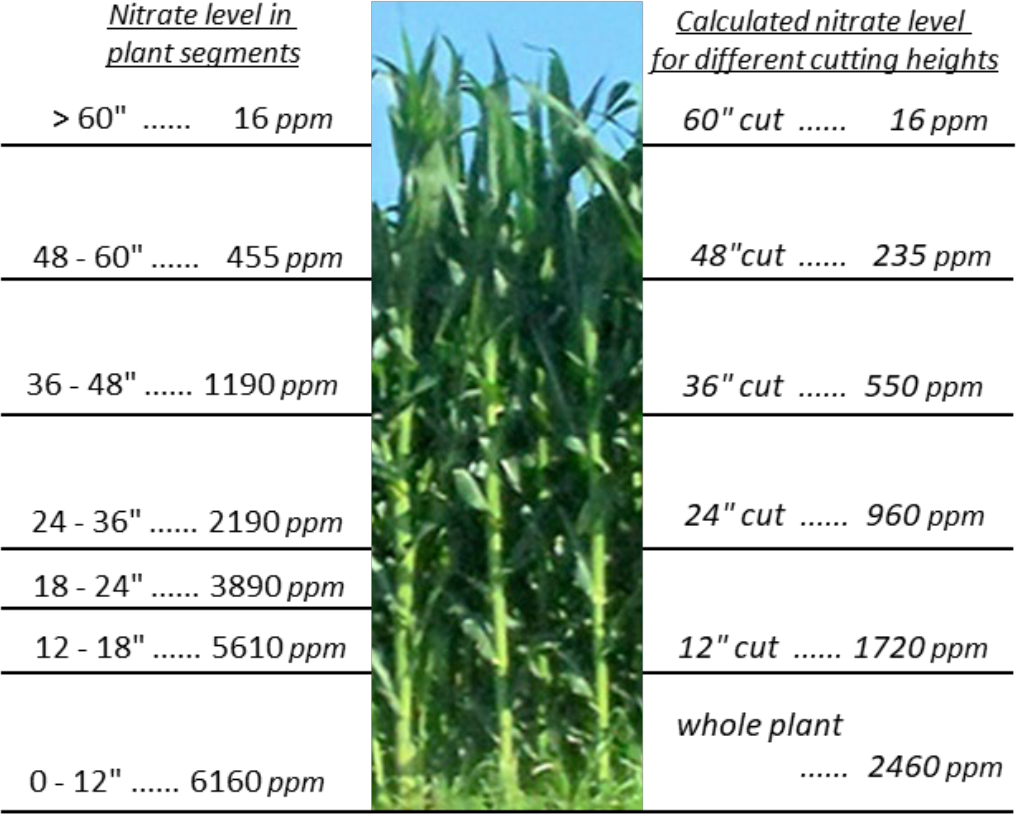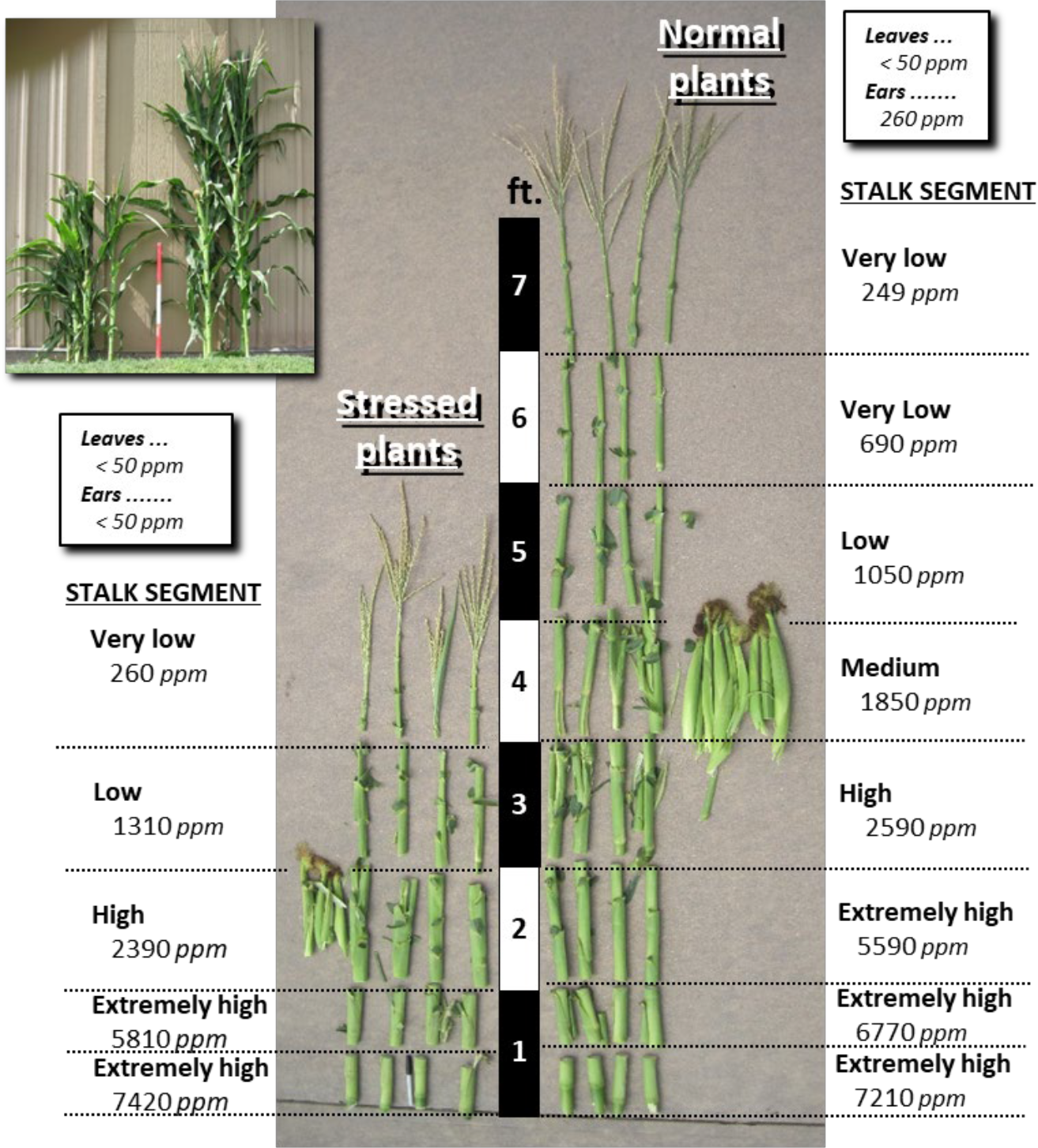⇦ Back to Crop Management Home
¶ Introduction
Drought-damaged corn may be salvaged for livestock feed. Harvest options depend on the growth stage, the stalk condition, ear and kernel development.
Drought-damaged corn fields will likely have corn plants in all stages of development. Emergence is often uneven. Parts of the field with better soil moisture may be the only plants with normal plant height or able to produce an ear.
This Crop File contains information harvest and storage of drought-damaged corn as silage or as “baleage” (round bale silage).
¶ A. General Considerations
- Check pesticide labels
- Check preharvest intervals and restrictions.
- Interval for corn harvested as grain may be quite different from corn to be harvested as forage.
- Check if preharvest intervals apply to dairy or beef cattle.
- Check insurance coverage
- Policy coverage can differ widely.
- Check with appropriate agent or adjuster to assure corn crop harvested as forage will qualify for coverage.
¶ B. Forage Quality Concerns
- Quality is variable because of variation in plant height, maturity, ear development, and grain fill.
- Drought-stressed leaves begin to yellow early, then die back from blade tip and edges.
- Leaves progressively die back from bottom to top of stalk.
- Leave plants with some grain development for as long as possible to allow further grain development.
- Grain will continue to fill, dry matter will increase, and silage quality will improve if crop receives rain.
- If pollination was unsuccessful and ears are barren, harvest as soon as plant moisture is appropriate for storage.
- Losing ear leaf and upper leaves seriously affects grain yields and forage quality.
- Leaf loss can result in nubbed ears, barren cobs, or partially filled ears.
- If leaf tissue has already turned brown due to drought, these leaves are no longer functional, even if rainfall is received.
- Green leaves that have rolled continue to photosynthesize and contribute to grain fill.
- Test harvested forage before feeding.
- Energy levels are likely to be lower; typically, about 70% to 90% of normal silage.
- Crude protein and fiber levels are likely higher if little or no grain in silage.
- Allowing for increased grain fill should increase starch production and higher energy levels.
- Delaying harvest as long as possible allows for maximum kernel development and total dry matter accumulation.
- Test nitrate levels before feeding drought-stressed forages.
- Predicting nitrate levels by growth stage, nitrogen fertilizer rate, or other factors is impossible.
- Harvest as silage or baleage?
- Silage may be better option with higher numbers of plants with ears and with 55% moisture or higher.
- Recommended storage moisture levels:
- 65% to 70% for bunkers
- 60% to 70% for bags
- 60% to 65% for upright stave silos
- 55% to 60% for upright oxygen-limiting silos
- 40% to 55% for baleage
¶ Figure 1. Harvest Height Impacts on Nitrate-Nitrogen (NO3-N) Levels

(after Hutjens, 2002).
¶ C. Nitrate Toxicity Concerns
- Accumulations generally highest in lower 12 to 18 inches of stalk.
- Nitrate levels gradually decline with plant height.
- Levels decline rapidly above ear, if one is present.
- Leaves, tassels, and upper stalk do not usually accumulate nitrate, even when drought stressed.
- Toxicity risk rises rapidly when forage is above 1000 to 1500 ppm NO3-N.
- Introduce high-nitrate feed gradually or dilute ration with low-nitrate feedstuffs.
- Cattle can be conditioned to eat progressively larger amounts of higher nitrate forage if amounts are gradually increased.
- Feeding carbohydrates as grain or concentrate helps dilute overall ration nitrate content.
- Animals consuming higher carbohydrate ration can tolerate more nitrate.
- Healthy, well-fed animals less likely to be affected than sick animals.
- Carbohydrates provide energy to rumen microbes; helps stimulate conversion of nitrate to nontoxic nitrogen compounds.
- About 30 to 60 percent of nitrates are lost during ensiling process.
- Nitrates do not totally dissipate.
- Some nitrates converted to gaseous forms of nitrogen; escape as silo gas.
- Nitrates also lost in liquid silage seepage during fermentation.
- Consider silage seepage as dangerous; should not be accessible to livestock.
¶ D. Corn Silage; Harvest and Storage
- Poorly harvested silage will have poor feed value.
- Best silage includes both grain and leaves.
- Often there is tendency to rush silage harvest to salvage corn crop
- Delay silage harvest until moisture reaches 64% to 72%.
- Ensiling with excess moisture (above 72%) without sufficient ear development is problem.
- Not enough carbohydrates present for proper fermentation.
- Often develops putrid silage with excessive seepage.
- Results in feed refusal and lost nutrients.
- Ensiling with excess moisture (above 72%) without sufficient ear development is problem.
- Excessively dry silage does not pack well.
- Poorly packed silage prone to have air pockets, to become moldy, to have more spoilage losses.
- Decreasing length of cut may help with packing
- Added water may be necessary to maintain satisfactory fermentation and help assure airtight (anaerobic) conditions.
- Add extra water as chopped forage is being put into storage.
- Adding water may not be feasible.
- Requires about 7 gallons of water per ton of silage to increase moisture content by 1%.
- Cutting height of 10 to 12 inches avoids stalk section that has highest nitrate levels
- Increased cutting height will reduce nitrate levels.
- Penalty will be lower silage yield.
- Whole-plant nitrate concentration should factor into cutting height decisions.
- Example from Figure 1: 24-inch cutting height reduces calculated nitrate level to 960 ppm NO3-N (generally safe level), but would greatly reduce tonnage.
- Chop silage at correct particle length.
- Do not chop too finely.
- Reduces effective fiber concentration.
- Fine chopping is not needed for good starch digestibility if plants have limited ear development.
- Theoretical length of cut of about 1/2-inch is acceptable
- Longer cut (3/4-inch) needed for with kernel processing and BMR silage.
- Correct length varies greatly between choppers and crop moisture concentrations.
- Do not chop too finely.
- Use kernel processor.
- Kernel processed corn silage tends to pack more densely than unprocessed corn silage
- May help increase aerobic stability.
- Will increase starch digestibility by breaking kernels. Poor starch digestibility is major problem with dry, mature corn silage.
- Use “buchneri” inoculants.
- Increases chance of successful fermentation.
- Severely drought-stressed corn can have elevated sugar concentrations.
- Stressed plants are not depositing starch into kernels.
- Sugars are food source for yeasts and molds.
- “Homolactic” inoculants (‘standard silage inoculants’) produce lactic acid.
- Reduces fermentation losses.
- Can sometimes increase spoilage during feedout.
- “Buchneri” inoculants increase acetic acid .
- Slightly increase fermentation losses.
- Greatly reduce spoilage during feedout.
- Increases chance of successful fermentation.
- Silage requires minimum of 21 days for fermentation.
- Ensiling reduces nitrate levels by 30% to 60%.
- Final nitrate level may still be high if levels were extremely high in fresh plants.
¶ E. Corn Baleage: Harvest and Storage
- Plants will likely need to be wilted for several hours to reach correct and safe moisture.
- Discbines and disc mowers work best.
- Take tension off of rollers to avoid ear loss.
- Flail mowers not advised; can also break off ears.
- Baler with precutter preferred.
- Produces tighter bales; improves baleage quality.
- Reduces amount of oxygen in bales; helps lower forage pH more quickly.
- Reduces length of time required before feedout.
- Reduces final processing time in TMR mixer.
- Set baler tension as much as possible.
- Helps produce tighter bales; less oxygen, better fermentation.
- Use baler that applies net wrap.
- Recommend using extra layer of net wrap.
- Helps to pull stalks together more tightly.
- Results in less puncturing of plastic.
- Wrap baleage with solid plastic as soon as possible after baling.
- Use at least 6 millimeters of plastic wrap (7 to 8 wraps).
- Avoid poking holes through plastic.
- Punctures allow spoilage and heating.
- Seal any holes as soon as noticed.
¶ Figure 2. Comparison of Nitrate-Nitrogen Levels and Nitrate Toxicity Ratings

¶ References
Livingston, et. al. 1995. Preventing Nitrate Problems in Drought-Damaged Corn. Pub. No. L-5149. Texas Agric. Ext. Svc., Texas A&M Univ., College Station TX. 4 pg.
Strickland, et. al. Nitrate Toxicity in Livestock. Pub. No. PSS-2903. Oklahoma Coop. Ext. Svc., Oklahoma State Univ., Stillwater OK. 6 pg.
Coulter, et. al. 2021. Harvesting drought-stressed corn as baleage. Minnesota Crop News. Univ. of Minnesota Extension. blog-crop-news.extension.umn.edu/2021/08/harvesting-drought-stressed-corn-as.html accessed 11Jul2023.
Popp, et.al. 2021. Harvesting drought-stressed corn for silage. Minnesota Crop News. Univ. of Minnesota Extension. blog-crop-news.extension.umn.edu/2021/08/harvesting-drought-stressed-corn-as.html accessed 11Jul2023.
Weiss, B. 2020. Making Corn Silage in Dry Conditions. Agronomic Crops Network, Ohio State Univ. Ext., Columbus OH. https://agcrops.osu.edu/newsletter/corn-newsletter/2020-28/making-corn-silage-dry-conditions accessed 11Jul2023